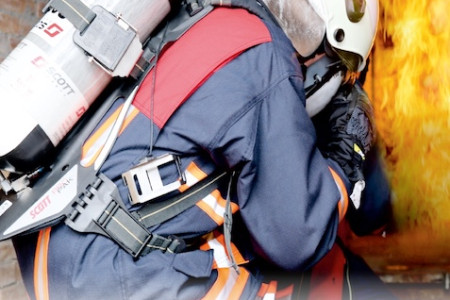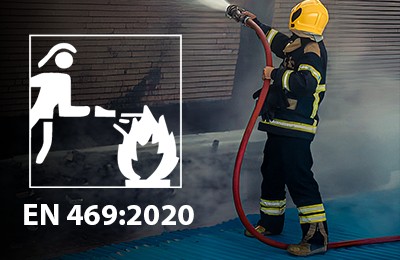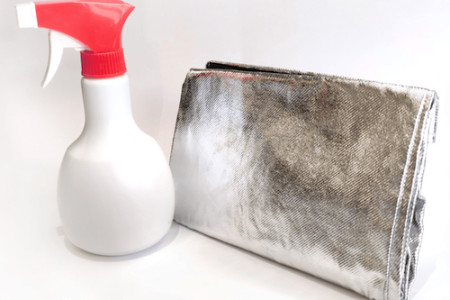Technique of Flame Retardant Protective Clothings
Fabrics for firefighting used in flame retardant clothings are manufactured from specially designed glass fiber or glass fiber blends. Commonly known flame retardant glass fiber is “aramid”. Aramid glass fibers are named according to their chemical bonds as metaaramid and paraaramid.
Flame retardant aramid glass fibers are produced by many companies. These aramid fibers are released to the market in different brand names.
Paraaramid glass fibers have higher resistance and better flame retardant properties than metaaramid glass fibers. These glass fibers in various brands and names show similar properties.
Some aramid fiber manufacturers and their brand names are shown below.
Meta-aramid (Polymeta-phenyleneisophtlamide)
Nomex® (DuPont – USA), Conex® (Teijin – Japan), Aramet®(Teijin – Japan), Kermel®( Kermel Rhodia- France), New Star® ( Yantai Spantex- China)
Para-aramid (Poly-para-phenylene Terephtalamide)
Twaron® (Teijin – Japan), Technora® (Teijin – Japan), Arenka® (Akzo- Netherland), Kevlar® (DuPont – USA), ARTEC® (JSC Kamenskvolokno - Russia)
Heat and flame retardant clothes are manufactured from these aramid glass fibers or blends which are manufactured with highly advanced technology. Performance of the fabric is determined by the blend rate of the aramid used in the fabric. With the determined performance properties, these fabrics can be used in various areas as stated below.
- Industry (petrol & gas, cement, aluminum & iron-steel, foundry, marine, search and rescue etc.)
- Electricity Distribution Companies, Military, Police Forces, Forest Firefighting
- Marine Firefighting, Fire Brigades
- Places or situations where the heat and flame may occur such as tanker fires, plane fires, disasters.
The main priority is the risk of the environment. After making a proper risk analysis, what type of fabric and what kind of garment to be used is determined and the protective clothing types that can be chosen is as explained below according to the type of the heat and flame and dangers of the environment. These garments can be produced as single of multi layered according to the risks.
Structural Firefighting Suits
FYRPRO® series fireman suits are manufactured as per EN 469:2005 standard and certified as per (EU) 2016/425 PPE Regulation as a requirement of Turkish and European Regulations.
FYRPRO® series firefighting suits-Fireman Clothings are Multi-layered and specially designed for the purposes which are more risky and dangerous. Protects against flame and also prevents the contact of chemicals and water to the skin (thanks to its moisture barrier that is breathable and has high penetration resistance).
Protective clothings used in firefighting are technical garments for professional purposes that need to be used by trained individuals. For this reason, not only manufacturers but also marketers must learn the technique and present it to end users. Manufacturers should not content of what they have and must apply to the latest versions of the standards and follow the innovations in their production.
Authorities in the firefighting departments, where these clothings has to be used, must be selective in choosing these garments, that is because they are protective equipment against fatal injuiries and examine the conformity of the related standards.
IST Safety Ltd releases technical firefighting suits to the market in the brand of FYRPRO and aluminized fire proximity suits, which are used in different firefighting techniques, in the brand of FYRAL.
EN 469:2005, which is the standard or fireman suits, standard defines the lowest limits of fire resistance of different heat types, and also includes the lowest value of the suit against water pressure and highest resistance values against water vapor permeance. They are categorized as Level 1 and Level 2 according to these factors. Level 2 suits provides the best protection and maximum comfort.
Main purpose of fireman suits is the protection of the user against heat stress. This is provided by using the high heat resistant layers and keeping the user dry. The greatest fact in the firefighting “Water” is fatal if stays on the firefighter.
Because water, transmits heat faster than air (21 times faster at 90 C), if the water is vapor, this will be much faster. In this respect, it is very important to preserve air spaces between layers used in the fireman suits. For this reason, moisture barriers in layer system are used. This barrier shows resistance to the water from outside and does not let the water in, also evacuates the moisture from sweating through the micro pores. Provides comfort and keeps the user dry.
Fireman suits are generally formed with 4 main layers.
- Outer layer (Fire retardant fabric which is resistant against heat and mechanical effects, water repellent)
- Moisture Barrier (PU or PTFE membrane laminated on aramid based conductor)
- Heat Barrier (Double or single layered, generally non-woven fire retardant layers)
- Inner Liner (May be quilted on heat barrier, low weight and comfortable fire retardant fabric)
What is the meaning of X, Y, Z and Level 1, Level 2 Protection Levels at fireman suits?
Two different performance levels are described in EN 469:2005 standard; level 1 and level 2. Level 2 suits provide higher protection than level 1 suits. Fireman suits should be marked according to their performance levels. For instance, X2, Y2, Z2 indicates level 2 suit or X2, Y2, Z1 indicates level 1 suit.
X defines the heat transfer level for flame and radiation.
Y defines the water penetration level.
Z defines the water vapor resistance level.
Following table shows related test methods and requirements for level 1 and level 2.
|
TESTS |
TEST METHOD |
PERFORMANCE LEVELS |
|||
|
Level 1 |
Marking |
Level 2 |
Marking |
||
|
HEAT TRANSFER-FLAME |
EN 367 |
HTI24≥ 9 s HTI24-HTI12≥ 3s
|
Xf1 |
HTI24≥ 13 s HTI24-HTI12≥ 4s |
Xf2 |
|
HEAT TRANSFER-RADIATION |
EN 6942 |
RHTI24≥ 10 s RHTI24-RHTI12 ≥ 3 s
|
Xr1 |
RHTI24≥ 18 s RHTI24-RHTI12 ≥ 4s
|
Xr2 |
|
RESISTANCE TO WATER PENETRATION
|
EN 20811 |
Level 1 < 20 kPa |
Y1 |
Level 2 ≥ 20 kPa |
Y2 |
|
WATER VAPOUR RESISTANCE |
EN 31092 |
Level 1 > 30 m2Pa/W |
Z1 |
Level 2 ≤ 30 m2Pa/W |
Z2 |
Routine Inspection Guide For FYRPRO® Series Fireman Suits
FYRPRO® fireman suits should be inspected in every six months, and after each use regardless of the last inspection date.
When performing a routine inspection for your fireman suit check for any;
- Thin spots
- Holes
- Tears
- Discoloration
- Embrittlement
- Bad smell due to humidity or fumigation
- If your suits has reinforcements on knees, elbows and/or shoulders, examine the reinforcements.
- Check elasticity of knitted cuffs and check thumb hole for any damage.
- Check for seam integrity. Any missing, loose, burn, torn or melted seams should be noted, and authorised people should be informed.
- Check for reflective trim functionality. Stand in a dark place, at least 20 feet away from the suit. Hold a flashlight and check the reflectiveness of the reflective tapes.
- Inspect all closure systems to make sure each is intact and operates properly.
- Examine hook and loop closure for worn, abraded or melted pieces. Objects that accumulated on hook portion may affect the performance of the closure system.
- Examine all zippers for functionality and corrosion.
- Examine shoulder suspenders on trousers, make sure they attach securely and examine for loss of elasticity.
- Check the label of the suit, the standard of the suit should be up to date.
Shelf life of our fireman suits is 10 years under the proper storage conditions in its own packaging. If any damage occurs, it is recommended not to use the suit and to consult the fire fighting department or your employer immediately.
Aluminized Fire Proximity Suits
FYRAL® Series fire proximity suits are professional technical suits that are need to be used by trained individuals. They are used in various firefighting techniques other than special designed FYRPRO® series structural firefighting suits. Employee must decide which firefighting suit should be used after making the risk analysis in case of fire.
FYRAL® series expert fireman suits – Aluminized fire proximity suits: They are used in the most dangerous fire zones. Protects entire human body including head, hands, eyes and feet by covering entirely. It is produced as multi layered. Aluminized outershell fabrics are used to reflect the radiant heat in the areas where the radiant heat occurs.
FYRAL® series fire proximity suits are manufactured as per EN 1486:2007 standard and certified as per (EU) 2016/425 PPE Regulation. Basically, the standard defines the lowest heat resistant limits for different heat types.
FYRAL® series fire proximity suits which have EN 1486:2007 standard are used with self contained breathing apparatus (SCBA) and aims to protect the user from heat stress by reflecting radiant heat. For this reason, special aluminized fabric is used as the outer layer which has pre property of reflecting the radiant heat.
The suits are formed with 3 or 4 main layers. Moisture barrier is optional and can be added according to area of use.
- Outer layer (Fire retardant fabric which is resistant against heat and mechanical effects, water repellent)
- Heat Barrier (Double or single layered, generally non-woven fire retardant layers)
- Inner Liner (May be quilted on heat barrier, low weight and comfortable fire retardant fabric)
- Moisture barrier is optional.
FYRAL® series suits are delivered with special aluminized gloves and rubber fireman boots in a special carrying bag. These complementary products must also conform to their own standards and must be supplied as a complete set as the suits is certified entirely with all accessories. In these kinds of suits, no body parts remain uncovered and a head protective helmet and gold vaporized reflective visor are included in the hood.









Your Comments